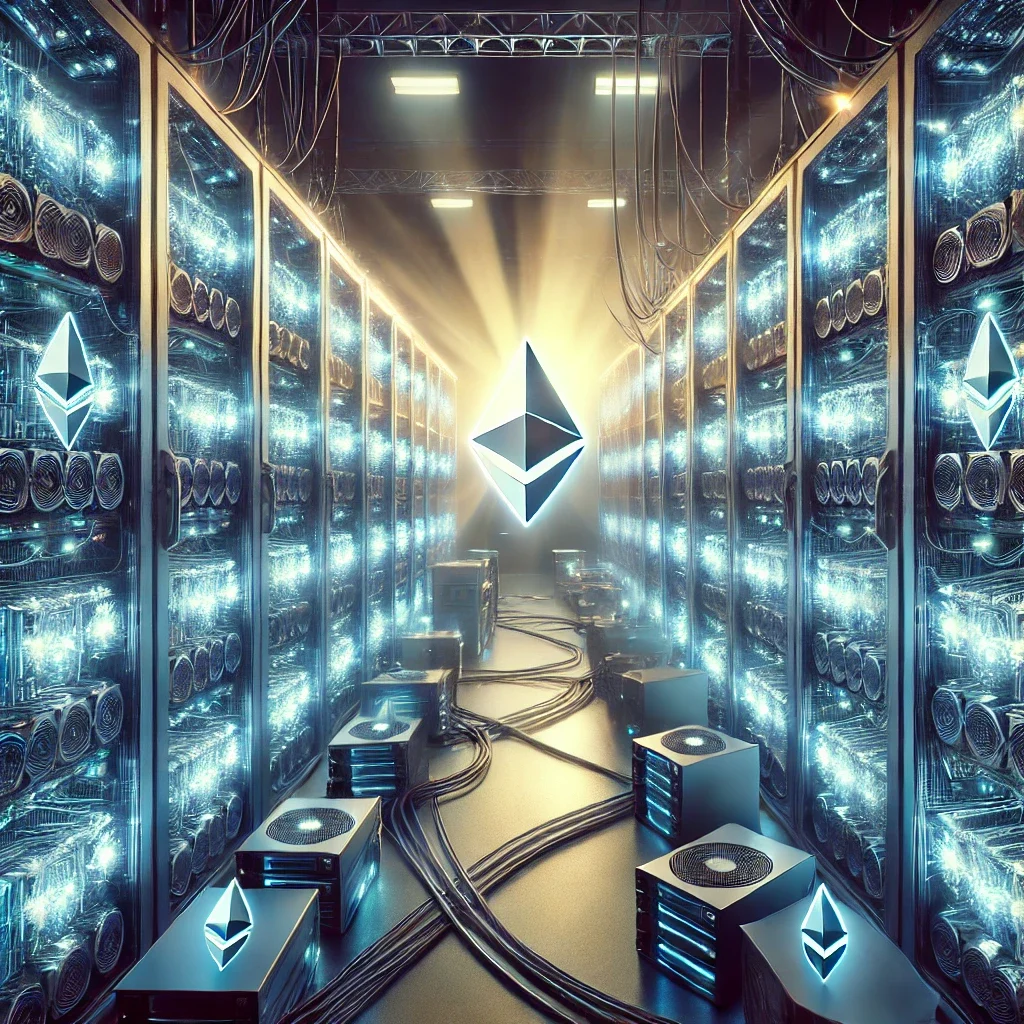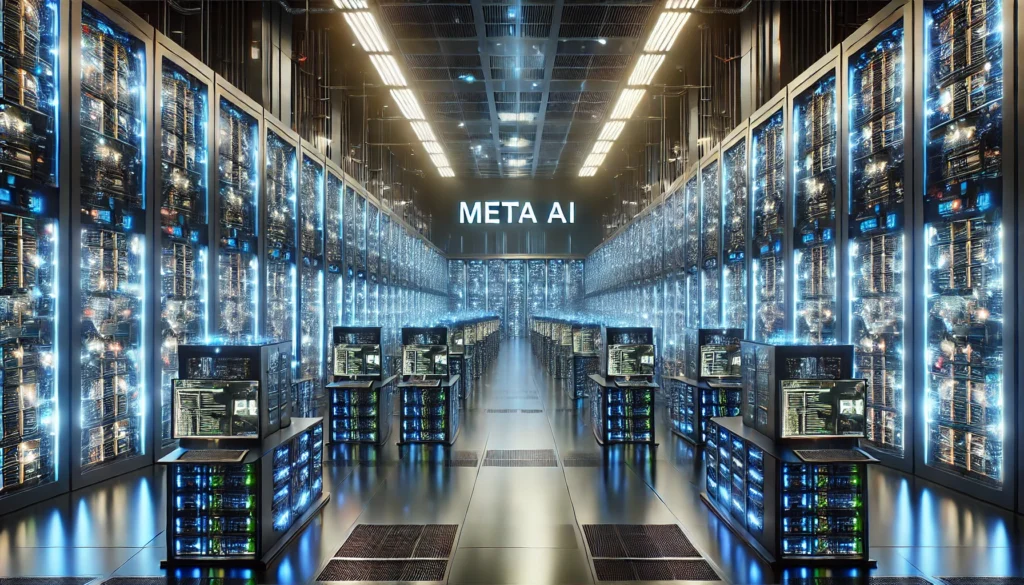Meta’s Massive AI Data Centers: A New Era in Supercomputing
Meta’s new AI superclusters, Prometheus and Hyperion, are set to revolutionize computing. Learn how Mark Zuckerberg plans to power AI with cutting-edge infrastructure
The AI Future is Here, and Meta is Leading the Charge
In an era where artificial intelligence is steadily shaping every corner of our lives—from the way we shop to how we interact with our devices—Meta (formerly Facebook) is gearing up to supercharge its AI ambitions with an unprecedented plan: massive AI data centers. These “superclusters,” including the behemoth Prometheus project, are not just about scaling up storage—they are reshaping how we understand power, computing, and data. Mark Zuckerberg and Meta’s big vision is a mix of awe-inspiring technological advancements and big environmental questions. Let’s take a deep dive into how these AI data centers are set to change the world.
Meta’s Bold Leap: Investing Billions in AI Data Centers
You’ve likely heard the phrase “big data” thrown around a lot, but what Meta is planning goes beyond just big—it’s super big. The tech giant is poised to spend hundreds of billions of dollars to build AI data centers that will power its next-generation artificial intelligence systems, potentially altering the course of the entire industry. But it’s not just about building bigger structures; it’s about building smarter, faster, and more sustainable infrastructures that can handle the insatiable demand for processing power.
This isn’t just a casual venture—Meta is betting on the future of AI, and the company’s ambitious plans are well underway. The Prometheus project, set to launch in 2026, promises to be the largest AI data center of its kind, with a staggering 1 gigawatt of energy capacity. That’s enough to power roughly 1 million homes.
Prometheus and Hyperion: The Titans of AI Infrastructure
Let’s break it down further.
Prometheus: Meta’s First AI Mega Data Center
Meta’s flagship project is called Prometheus, a colossal AI data center located in New Albany, Ohio. With 1 GW of energy capacity, it’s designed to handle the AI workloads that are growing exponentially in both scope and complexity. Think about AI systems that will be responsible for processing millions of requests every second, analyzing massive datasets, and even improving AI models as they learn. It’s like the brain of the internet—only way bigger, faster, and more powerful.
And while Prometheus will be the first of its kind, Meta has plans to expand. The second supercluster, Hyperion, will be built in Richland Parish, Louisiana. Hyperion, expected to eventually scale up to 5 GW, will house advanced AI systems and next-gen computing technologies. These massive data centers will help Meta push the boundaries of what AI can do, from improving virtual reality (VR) to making more accurate predictions in fields like health, finance, and robotics.
Hyperion’s Massive Scale: What’s at Stake
Hyperion’s sheer scale is mind-blowing. The first phase, slated for completion by 2027, will consume 1.5 GW of electricity, an immense power demand that brings both opportunities and challenges. To put things into perspective, this is roughly the same amount of electricity required to power a small country. When fully operational, Hyperion will be large enough to rival the entire footprint of Manhattan. That’s right—these data centers will occupy land on a massive scale, reshaping local infrastructure and economies.
AI Needs Energy, and Meta is Powering Up
When we talk about AI, one of the first things that come to mind is processing power. But behind the raw computing capabilities, there’s a major behind-the-scenes player: energy. Meta’s AI superclusters aren’t just running on any old energy—they need massive amounts of electricity to function.
To meet these energy demands, Meta is tapping into a combination of renewable energy sources and natural gas turbines. In Ohio, for example, two 200-megawatt natural gas plants will be constructed to exclusively power the Prometheus center. While this helps Meta secure a consistent power supply, it also raises concerns about carbon emissions and the environmental impact of such large-scale projects.
Balancing Progress and Environmental Impact
Meta is committed to reducing its carbon footprint and has made strides in incorporating renewable energy into its operations. However, the scale of these data centers raises important questions: Can AI development grow without negatively impacting the planet? The Prometheus and Hyperion centers will certainly require a lot of electricity, and even though Meta has pledged to balance this with green energy sources, it’s clear that AI’s hunger for data will be a constant challenge for environmental sustainability.
The Promises and Perils of Meta’s Superclusters
There’s no doubt that Meta’s AI superclusters are a monumental step forward for the industry. These data centers will not only increase the speed of artificial intelligence but also expand its scope. From AI-driven healthcare innovations to creating more personalized user experiences in social media and beyond, the possibilities are endless.
However, as with any game-changing technology, there are inherent risks. We’ve seen how AI can influence everything from privacy to job markets, and the growth of massive data centers might be one more domino in the chain of technological disruption. Will these superclusters make the internet smarter? Definitely. But can we maintain the balance between progress and environmental protection? That’s a question Meta—and all of us—will need to answer.
The Bigger Picture: What This Means for the AI Industry
Meta’s investments in these superclusters signal a larger shift in the AI industry. It’s not just about improving the algorithms or expanding machine learning capabilities—it’s about creating the infrastructure to handle the future. As companies like Meta, Google, and Microsoft continue to dominate the AI space, the need for scalable, efficient, and sustainable data centers will only grow.
This doesn’t just impact Meta; it affects how all industries will use AI. From healthcare to finance to entertainment, the demand for faster, more intelligent AI systems will grow, creating new opportunities—and challenges—for businesses and consumers alike.
Meta’s Superclusters—The Future is Now
Meta is diving headfirst into an era where AI meets massive infrastructure, setting the stage for a future of limitless possibilities. But with this bold move comes an equally important responsibility: ensuring that the promise of AI doesn’t come at the cost of our planet. Meta’s commitment to innovation is clear, but the true test will be how they balance this ambition with sustainability.
What do you think about Meta’s supercluster projects? Will these vast data centers change the way we interact with AI, or will they simply create more problems? Drop your thoughts in the comments below—let’s start a conversation.
Also check – Mark Zuckerberg: From Dorm Room to Meta Mogul – A Billionaire’s Journey –







https://t.me/s/uD_fRESH
https://t.me/s/UD_iRWIn
https://t.me/s/Ud_GAMa
https://t.me/s/Ud_catcasINo
https://t.me/s/ud_1Go
https://t.me/s/UD_jEt
https://t.me/s/official_1win_aviator/38
https://t.me/s/ud_JoycaSino
https://t.me/s/ud_StaKe
https://t.me/s/official_1win_aviator/74
https://t.me/s/uD_dRagonMOneY
https://t.me/s/Official_mellstroy_casino
https://t.me/s/ud_MarTin
9hgbe2
https://t.me/s/tf_1win
https://t.me/s/tf_1win
https://t.me/s/kfo_1win
https://t.me/s/Top_bk_ru
https://t.me/s/Ud_gAMa
https://t.me/s/uD_mArTIN
https://t.me/s/ud_PLAYfortunA
Really great information can be found on website.
https://t.me/s/uD_LEgzO
https://t.me/s/ud_gIZbo
https://t.me/s/Ud_LEX
https://t.me/s/ud_CAsiNo_X
https://t.me/s/UD_pokeRdOM
https://t.me/s/Ud_StarDa
https://t.me/s/ud_riObet
https://t.me/s/uD_Izzi
https://t.me/s/UD_PInco
https://t.me/s/ke_Martin
https://t.me/s/kef_Rox
https://t.me/s/kef_R7
https://t.me/official_1win_aviator/205
https://t.me/s/ke_Pin_Up
https://t.me/s/ke_Starda
https://t.me/s/ke_mellstroy
https://t.me/s/ke_1xbet
https://t.me/s/ke_CatCasino
https://t.me/s/ke_1Go
https://t.me/s/ke_PlayFortuna
https://t.me/s/ke_Gama
https://t.me/s/ke_Booi
https://t.me/s/ke_Monro
https://t.me/s/ke_JoyCasino
https://t.me/s/ke_Pokerdom
https://t.me/s/ke_DragonMoney
https://t.me/s/ke_Vulkan
https://t.me/s/ke_Legzo
https://t.me/s/ke_kent
https://t.me/s/ke_Fresh
https://t.me/s/ke_Leon
https://t.me/s/kef_Lex
https://t.me/s/ke_Kometa
https://t.me/s/ke_Casino_X
https://t.me/s/ke_MrBit
https://t.me/s/ke_Flagman
https://t.me/s/ke_1xSlots
https://t.me/s/ke_Izzi
https://t.me/s/ke_Pinco
https://t.me/s/ke_1Win
https://t.me/s/official_1win_aviator/210
https://t.me/s/ke_Vodka
https://t.me/s/ke_Sol
https://t.me/s/ke_Jet
https://t.me/s/kef_beef
https://t.me/s/ke_Irwin
https://t.me/s/ke_Daddy
https://t.me/s/ke_Riobet
https://t.me/s/top_kazino_z
https://t.me/s/topcasino_v_rossii
https://t.me/s/a_Top_onlinecasino/3
https://t.me/s/a_Top_onlinecasino/8
https://t.me/a_Top_onlinecasino/21
https://t.me/a_Top_onlinecasino/18
https://t.me/a_Top_onlinecasino/17
https://t.me/a_Top_onlinecasino/19
https://t.me/a_Top_onlinecasino/9
https://t.me/s/a_Top_onlinecasino/10
https://t.me/a_Top_onlinecasino/15
https://t.me/s/a_Top_onlinecasino/13
https://t.me/a_Top_onlinecasino/11
https://t.me/topcasino_rus/
https://t.me/s/official_Booi_es
https://t.me/s/official_Pinco_ed
https://t.me/s/official_PinUp_es
https://t.me/s/official_GGBet_es
https://t.me/s/official_Pokerdom_es
https://t.me/s/official_Drip_ed
https://t.me/s/official_MostBet_ed
https://t.me/s/official_Kometa_ed
Its such as you read my mind! You appear to know a lot approximately this, such as you wrote the guide in it or something. I think that you could do with a few percent to drive the message home a little bit, however instead of that, this is wonderful blog. A great read. I will definitely be back.
https://t.me/s/official_R7_es
https://t.me/s/official_PlayFortuna_ed
https://t.me/s/official_Daddy_ed
https://t.me/s/official_Pokerdom_ed
https://t.me/s/official_GGBet_ed
https://t.me/s/official_Sol_ed
https://t.me/s/official_Daddy_es
Would you be taken with exchanging hyperlinks?
https://t.me/s/official_Martin_es
https://t.me/s/official_Martin_ed
https://t.me/s/official_Vodka_ed
Very good blog you have here but I was wanting to know if you knew of any forums that cover the same topics talked about here? I’d really love to be a part of community where I can get advice from other experienced people that share the same interest. If you have any recommendations, please let me know. Kudos!
https://t.me/s/official_Volna_es
https://t.me/s/official_Legzo_es
https://t.me/s/official_Kent_es
https://t.me/s/official_R7_ed
https://t.me/s/official_Riobet_ed
https://t.me/s/official_JoyCasino_ed
https://t.me/s/official_Kometa_es
https://t.me/Gizbo_egs/20
https://t.me/s/iGaming_live/4634
https://t.me/Rox_egs/16
https://t.me/s/JoyCasino_egs/12
https://t.me/s/?@DragonMoney_egs/14
https://t.me/s/Leon_egs/7
https://t.me/s/PinUp_egs/11
https://t.me/s/Stake_egs/5
https://t.me/s/R7_egs/15
https://t.me/s/Kometa_egs/20
https://t.me/s/Vodka_egs/14
https://t.me/Kent_egs/9
https://t.me/PlayFortuna_egs/14
https://t.me/Daddy_egs/15
https://t.me/Riobet_egs/19
https://t.me/R7_egs/4
https://t.me/s/Volna_egs/7
https://t.me/s/Kent_egs/22
https://t.me/s/CatCasino_egs/7
https://t.me/s/?@DragonMoney_egs/13
https://t.me/Rox_egs/6
https://t.me/s/Pinco_egs/5
https://t.me/CatCasino_egs/9
https://t.me/s/Kent_egs/21
https://t.me/va_1xbet
https://t.me/iGaming_live/4552
https://t.me/s/va_1xbet/5
https://t.me/va_1xbet/7
https://t.me/s/va_1xbet/24
https://t.me/s/va_1xbet/15
https://t.me/s/va_1xbet/20
https://t.me/s/va_1xbet/4
https://t.me/va_1xbet/5
https://t.me/va_1xbet/21
https://t.me/s/va_1xbet/18
https://t.me/va_1xbet/12
https://t.me/s/va_1xbet/9
https://t.me/s/surgut_narashchivaniye_nogtey/19
https://t.me/s/surgut_narashchivaniye_nogtey/17
https://t.me/surgut_narashchivaniye_nogtey/13
https://t.me/s/ah_1xbet/5
https://t.me/ah_1xbet/20
https://t.me/s/ah_1xbet/21
https://t.me/s/ah_1xbet/14
https://t.me/s/ah_1xbet/3
https://t.me/ah_1xbet/10
https://t.me/ah_1xbet/14
https://t.me/ah_1xbet/17
https://t.me/ah_1xbet/7
https://t.me/s/Best_rating_casino
https://t.me/s/reyting_topcazino/16
https://t.me/topcasino_rus/
https://t.me/top_ratingcasino/8
https://t.me/top_ratingcasino/3
https://t.me/a_Topcasino/6
https://t.me/a_Topcasino/9
https://t.me/top_ratingcasino/5
https://t.me/a_Topcasino/7
https://t.me/top_ratingcasino/6
https://t.me/top_ratingcasino/7
https://telegra.ph/Top-kazino-11-14-2
https://t.me/s/kazino_bez_filtrov
https://t.me/kazino_bez_filtrov
https://t.me/da_1xbet/15
https://t.me/da_1xbet/14
https://t.me/da_1xbet/13
https://t.me/da_1xbet/12
https://t.me/da_1xbet/2
https://t.me/da_1xbet/8
https://t.me/da_1xbet/3
https://t.me/da_1xbet/4
https://t.me/da_1xbet/7
https://t.me/rq_1xbet/1450
https://t.me/rq_1xbet/1068
https://t.me/rq_1xbet/1105
https://t.me/s/rq_1xbet/796
https://t.me/s/rq_1xbet/1329
https://t.me/s/rq_1xbet/675
https://t.me/s/rq_1xbet/1022
https://t.me/s/rq_1xbet/1134
https://t.me/Official_1xbet1/1021
https://t.me/Official_1xbet1/385
After study a few of the blog posts on your website now, and I truly like your way of blogging. I bookmarked it to my bookmark website list and will be checking back soon. Pls check out my web site as well and let me know what you think.
https://t.me/s/Official_1xbet1/1265
https://t.me/s/Official_1xbet1/158
https://t.me/s/Official_1xbet1/573
https://t.me/s/Official_1xbet1/1129
https://t.me/s/Official_1xbet1/1070
https://t.me/s/Official_1xbet1/881
https://t.me/s/Topcasino_licenziya/34
https://t.me/s/Topcasino_licenziya/22
https://t.me/Topcasino_licenziya/24
https://t.me/s/Topcasino_licenziya/40
https://t.me/s/Topcasino_licenziya/30
https://t.me/Topcasino_licenziya/20
https://t.me/s/top_online_kazino/7
https://t.me/s/top_online_kazino/4
https://t.me/s/top_online_kazino/7
https://t.me/top_online_kazino/9
https://t.me/s/top_online_kazino/6
https://t.me/top_online_kazino/7
https://t.me/s/top_online_kazino/9
https://t.me/top_online_kazino/6
https://clients1.google.com.et/url?sa=t&url=https://t.me/Official_1xbet_1xbet/1402
http://frasermail.com/__media__/js/netsoltrademark.php?d=https://t.me/s/Official_1xbet_1xbet/1710
http://conservationgrass.net/__media__/js/netsoltrademark.php?d=https://t.me/Official_1xbet_1xbet/1629
https://www.avito.ru/surgut/predlozheniya_uslug/apparatnyy_manikyur_i_pedikyur_s_pokrytiem_4030660549?utm_campaign=native&utm_medium=item_page_ios&utm_source=soc_sharing_seller
https://maps.google.si/url?sa=t&url=https://t.me/Official_1xbet_1xbet/861
https://yorksite.ru/goto.php?url=https://t.me/Official_1xbet_1xbet/1481
https://maps.google.co.bw/url?sa=t&url=https://t.me/Official_1xbet_1xbet/1018
https://t.me/top_casino_rating_ru/11
https://t.me/s/om_1xbet/9
https://t.me/om_1xbet/7
https://t.me/om_1xbet/8
https://t.me/s/om_1xbet/3
https://t.me/om_1xbet/11
https://t.me/s/om_1xbet/5
https://t.me/top_casino_rating_ru/14
https://t.me/top_casino_rating_ru/7
https://t.me/om_1xbet/13
https://t.me/Beef_Casino_rus/160
Promo 1win — заработай легко с онлайн-казино и ставками на спорт! Получи бонусы за депозит до 100%’, фриспины и кэшбэк 10%, играй в слоты, делай лайв-ставки с высокими коэффициентами и выводи выигрыш за минуты. Присоединяйся, вводи промокод и наслаждайся быстрым выводом и доступом 24/7 в личном кабинете!
1win apk download – скачивай и получай максимум возможностей! Открой доступ к онлайн-казино с слотами и фриспинами, делай ставки на спорт и лайв-ставки с высокими коэффициентами, получай бонусы за депозит до 5000? и промокодами, делай быстрый вывод выигрышей и пользуйся кэшбэком до 10%. Регистрация простая, минимальный депозит — всего 100?, а круглосуточный личный кабинет гарантирует связи с реальными выигрышами и мгновенными выплатами.